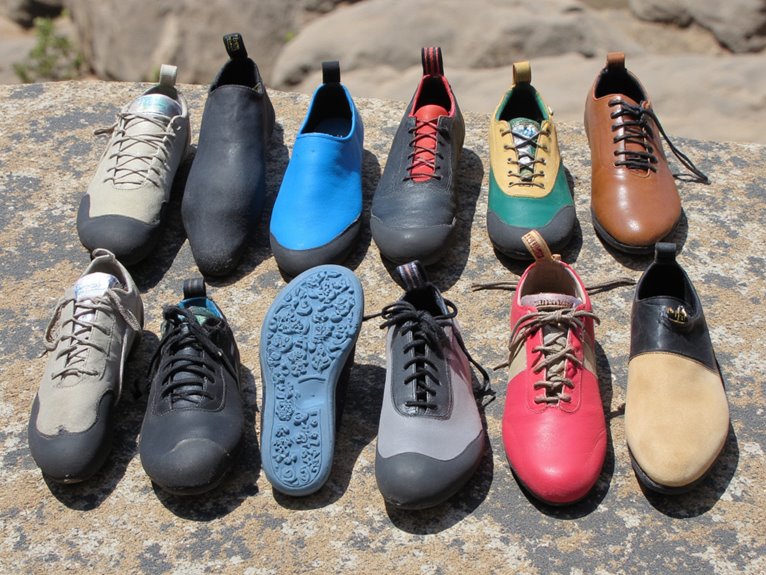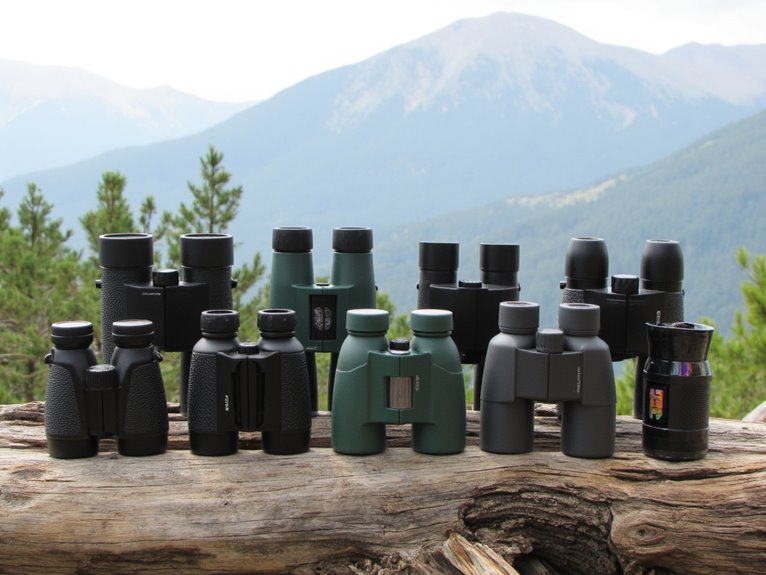10 Best Bouldering Shoe
I’ve researched dozens of bouldering shoes and consistently recommend the La Sportiva Solution for its aggressive downturn and precise edging on technical problems. The Scarpa Vapor V delivers exceptional sensitivity for delicate footwork, while Ocun’s Jett series offers superior comfort during extended sessions. For aggressive climbing, I prefer the Ocun Bullit’s stiff construction and sticky rubber compound. Each model requires careful sizing—typically half a size down from street shoes—to maximize performance on challenging routes and release their complete potential.
We are supported by our audience. When you purchase through links on our site, we may earn an affiliate commission, at no extra cost for you. Learn more. Last update on 4th December 2025 / Images from Amazon Product Advertising API.
Notable Insights
- Aggressive shoes with pronounced downturns excel at bouldering by providing superior power and grip on small, challenging footholds.
- Proper sizing requires downsizing at least half a size from street shoes for optimal performance and secure fit.
- High-quality shoes offer better durability, grip, and sensitivity, justifying the investment for serious boulderers seeking performance improvements.
- Comfort features like soft construction materials and proper fit prevent foot fatigue during extended bouldering sessions.
- Premium materials including quality rubber compounds and reinforced stitching provide long-term value through enhanced wear resistance.
La Sportiva Mens Solution Rock Climbing Shoe

The La Sportiva Mens Solution serves as a precision instrument for experienced climbers who demand maximum performance on challenging routes. You’ll find this aggressive shoe excels in bouldering and competition environments. Size down for ideal fit—this prevents foot slippage during technical sequences. The shoe’s aggressive downturn enhances toe grip considerably.
You shouldn’t consider this shoe if you’re beginning your climbing journey. It’s designed for intermediate to advanced climbers tackling V5 and beyond. Users report progression from 5.12a to 5.13 grades after switching to the Solution. The shoe performs exceptionally on moon walls and overhanging terrain.
Wide-footed climbers will appreciate the accommodating fit despite the shoe’s reputation for running small. You’ll experience improved footwork precision on micro-holds and technical sequences where every contact point matters.
Best For: Intermediate to advanced climbers who need maximum performance on challenging routes, bouldering, and competition climbing at V5+ difficulty levels.
Pros:
- Aggressive downturn provides exceptional toe grip and precision on micro-holds and technical sequences
- Proven performance enhancement with users reporting progression from 5.12a to 5.13 grades
- Accommodating fit for wide-footed climbers despite running small in size
Cons:
- Not suitable for beginner climbers due to aggressive design
- Requires sizing down which may affect comfort for extended wear
- Specialized performance focus limits versatility for casual climbing
Ocun Jett Lu Bouldering Shoe | Rock Climbing Shoe

Precision and comfort converge in the Ocun Jett Lu Bouldering Shoe, making it an ideal choice for climbers who demand extended session performance without sacrificing technical capability. You’ll experience immediate comfort on rock surfaces from day one. The high-quality sole delivers exceptional grip and stability vital for confident foot placement.
After thirty minutes of continuous climbing, you may notice slight discomfort. However, this doesn’t compromise your climbing confidence or performance. The shoe’s construction uses premium materials that guarantee long-term durability and justify the price point.
You’ll appreciate how these shoes maintain their form during falls, providing essential safety benefits. Both beginners and experienced climbers trust the Jett Lu’s reliable performance on gym walls and outdoor routes alike.
Best For: Climbers seeking a versatile bouldering shoe that balances precision and comfort for both extended gym sessions and outdoor routes, suitable for beginners and experienced climbers alike.
Pros:
- Exceptional grip and stability with high-quality sole construction for confident foot placement
- Immediate comfort from first use with well-constructed premium materials ensuring long-term durability
- Maintains form during falls and performs reliably across different climbing environments
Cons:
- May cause slight discomfort after 30 minutes of continuous climbing
- Higher price point, though justified by quality craftsmanship
- Limited information available about sizing recommendations or break-in period
Ocun Bullit Bouldering Shoe | Rock Climbing Shoe
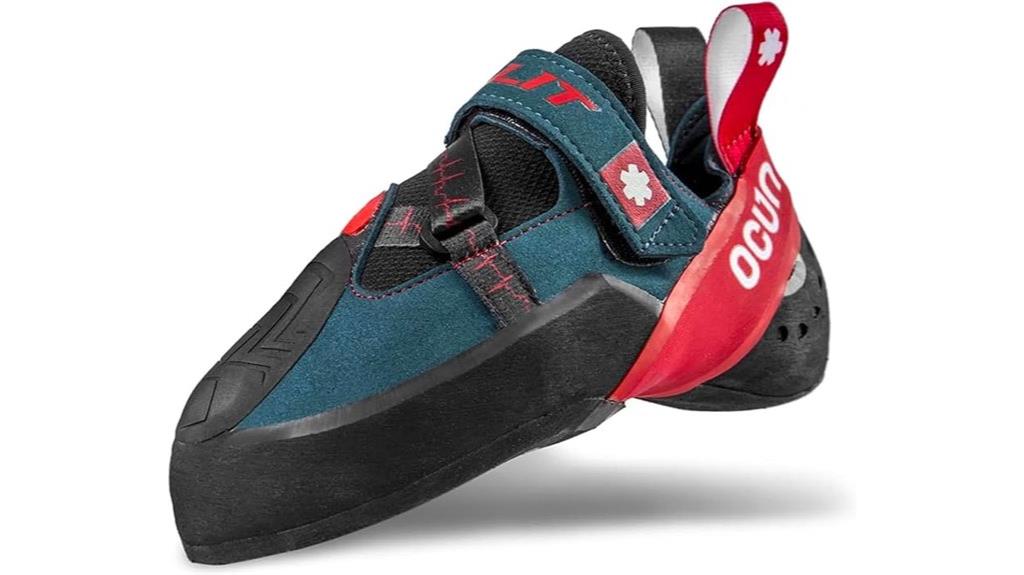
Climbers with wider feet and Morton’s toe will find exceptional performance in Ocun’s Bullit bouldering shoe. The toebox features a wider profile with gentle tapering that accommodates Greek foot anatomy comfortably. You’ll experience powerful toe performance combined with strategic flexibility placement throughout the shoe.
The mid-foot delivers exceptional softness while maintaining stiff toe construction for precise edging. Rubber thickness provides adequate protection without compromising sensitivity on volumes and natural stone. You’ll appreciate the grip performance during outdoor sport climbing sessions.
Sizing runs extremely small—expect to size up 1.5 to 2 full sizes from your street shoe measurement. Aggressive downsizing causes significant toe pain, particularly for Roman foot types with longer middle toes. Test multiple sizes carefully to avoid discomfort.
Best For: Climbers with wider feet and Morton’s toe who need a powerful bouldering shoe with strategic flexibility for outdoor sport climbing and natural stone.
Pros:
- Wider toebox with gentle tapering accommodates Greek foot anatomy and Morton’s toe comfortably
- Strategic construction combines powerful toe performance with mid-foot softness and stiff edging capability
- Excellent grip performance on volumes and natural stone with adequate rubber thickness for protection
Cons:
- Sizing runs extremely small, requiring 1.5 to 2 full sizes up from street shoe size
- Aggressive downsizing causes significant toe pain, especially for Roman foot types with longer middle toes
- Fit varies significantly based on individual foot profiles, making proper sizing challenging
Ocun Advancer QC and LU Bouldering Shoe for Advanced Climbers
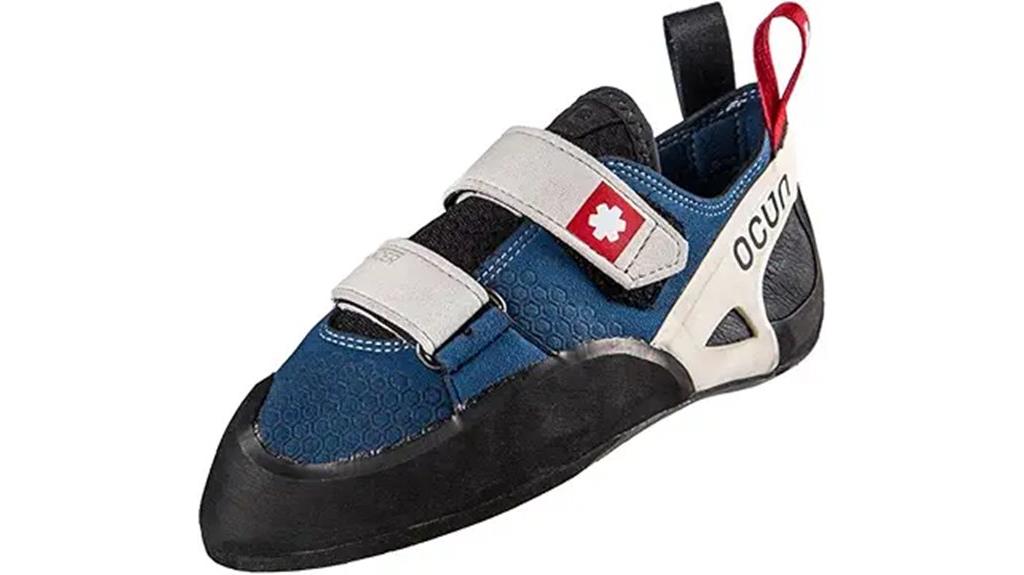
Advanced boulderers seeking versatile performance across indoor and outdoor terrain will find exceptional value in Ocun’s Advancer QC and LU models. These shoes deliver reliable performance for climbers tackling grades 5.8 through 5.11. You’ll appreciate the comfortable fit that accommodates various foot shapes without sacrificing precision on technical holds.
The sizing follows Ocun’s standard recommendations accurately. You can expect consistent performance whether you’re training indoors or projecting outdoor problems. While you might prefer aggressive shoes like Dragos for harder sends, these Advancers excel as all-day comfort options. The construction supports resoling with stickier rubber compounds when you’re ready to push into advanced grades.
Best For: Advanced boulderers who want comfortable, versatile climbing shoes for indoor and outdoor climbing in the 5.8-5.11 grade range and value all-day wearability over aggressive performance.
Pros:
- Comfortable fit that accommodates various foot shapes without sacrificing precision
- Great value for the price with reliable performance across indoor and outdoor settings
- Resole-friendly construction allows upgrading to stickier rubber for advanced climbing needs
Cons:
- Not as aggressive as specialized shoes like Dragos for harder climbing grades
- May require resoling with stickier rubber to meet advanced climbing performance demands
- Limited information available about long-term durability and wear patterns
SCARPA Mens Vapor V Rock Climbing Shoes for Sport Climbing and Bouldering

SCARPA’s Vapor V climbing shoes deliver exceptional out-of-the-box comfort that eliminates the painful break-in period most climbers endure with aggressive footwear. You’ll experience immediate performance with precise edging capabilities for both sport climbing and bouldering routes. Size down one full size from your street shoe, though wide feet should consider staying true to size.
The suede and Lorica upper construction provides decent durability for moderate use. However, you’ll notice the sensitive heel design can slip during dynamic movements. The Velcro closure system requires careful handling to prevent strap damage. These shoes excel as reliable gym trainers for strong beginners and intermediate climbers seeking comfort over maximum aggression.
Best For: Strong beginners and intermediate climbers who prioritize comfort and immediate performance for gym training, sport climbing, and bouldering over maximum aggression.
Pros:
- Exceptional out-of-the-box comfort with no painful break-in period required
- Precise edging capabilities that deliver immediate performance for sport climbing and bouldering
- Reliable construction with suede and Lorica upper materials for moderate use durability
Cons:
- Sensitive heel design tends to slip during dynamic and aggressive movements
- Velcro closure system is prone to damage if tightened too forcefully
- May experience rapid deterioration under heavy gym use compared to more robust climbing shoes
La Sportiva Mens Solution Comp Rock Climbing Shoes

The La Sportiva Solution Comp delivers exceptional flexibility and sensitivity that makes it an ideal choice for lighter-weight male boulderers who prioritize precision over aggressive power. This shoe maintains the asymmetric, down-turned profile of the original Solution while offering enhanced heel sensitivity for effective heel-hooks. You’ll notice minimal break-in time – most climbers find comfortable fit within days.
Size down at least one full US size, as these shoes stretch faster than expected. The soft construction provides true-to-size comfort for many users. Some climbers experience closure strap length issues requiring adjustments. Despite occasional quality control concerns regarding shipping condition, the shoes demonstrate solid durability, lasting approximately one year under regular circuit climbing. For serious boulderers needing reliable performance across various conditions, these represent strong value.
Best For: Lighter-weight male boulderers who prioritize precision and sensitivity over aggressive power and need a shoe with minimal break-in time for various climbing conditions.
Pros:
- Exceptional flexibility and sensitivity with enhanced heel performance for effective heel-hooks
- Minimal break-in period with comfortable fit achieved within just a couple of days
- Strong durability lasting approximately one year under regular circuit climbing use
Cons:
- Shoes stretch faster than expected, requiring sizing down at least one full US size
- Some users experience closure strap length issues that require adjustments for proper fit
- Occasional quality control problems with items arriving dirty or scuffed from sellers
Ocun Striker QC Bouldering Shoe I Rock Climbing Shoe

Boulderers seeking maximum comfort during extended climbing sessions will find the Ocun Striker QC delivers exceptional all-day wearability without sacrificing performance. You’ll want to downsize 0.5 from your street shoe size for ideal fit. The flat profile makes toe and heel hooks manageable while providing superior comfort compared to aggressive designs.
The rubber compound offers excellent grip without excessive stiffness, perfect for moderate climbing applications. You’ll appreciate the durability—customers report solid performance after three months of regular gym use. The soft construction allows natural foot movement while maintaining climbing precision.
These shoes excel at extended bouldering sessions where comfort becomes essential. The design withstands heavy gym use while delivering consistent performance across various climbing styles.
Best For: Boulderers and climbers who prioritize comfort during extended climbing sessions and prefer a flat, non-aggressive shoe design for all-day wearability.
Pros:
- Exceptional comfort for extended wear with soft construction that allows natural foot movement
- Excellent rubber grip that’s not overly stiff, making it ideal for moderate climbing applications
- Good durability with customers reporting solid performance after months of regular gym use
Cons:
- Flat profile may limit performance on extremely technical routes that benefit from aggressive downturned shoes
- Sizing requires careful consideration as most users need to downsize 0.5 from street shoe size
- Limited feedback on long-term durability beyond the initial few months of use
Ocun Fury Bouldering Shoe | Rock Climbing Shoe
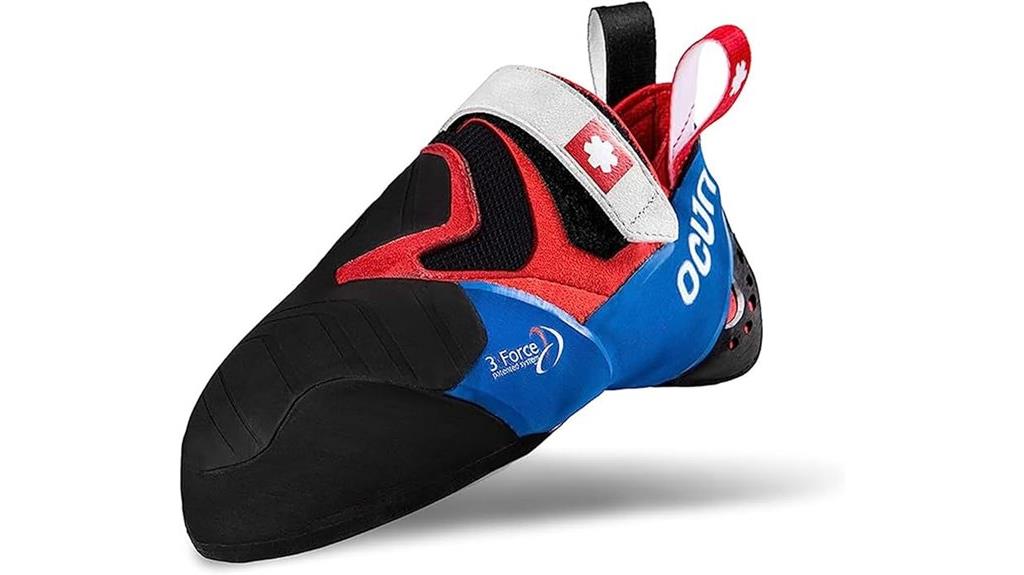
Climbing enthusiasts seeking an aggressive bouldering shoe that won’t break the bank find exceptional value in the Ocun Fury. You’ll experience comfort straight from the box, making this shoe a perfect balance between performance and comfort. Size down one full size from your street shoe—a size 46 street shoe translates to 45.5 in the Fury.
The Fury excels at smearing techniques but struggles with precise edging. You can confidently place your full body weight on small footholds thanks to its aggressive design. Regular to narrow feet achieve ideal fit, though aggressive sizing may cause initial discomfort.
Durability exceeds expectations, with users reporting months of heavy use. The Fury outlasts expensive competitors like Sportiva Solutions while maintaining affordability.
Best For: Budget-conscious climbers with regular to narrow feet who prioritize smearing techniques and want an aggressive bouldering shoe that provides immediate comfort without sacrificing durability.
Pros:
- Comfortable right out of the box with excellent balance between performance and comfort
- Superior durability that outlasts expensive competitors like Sportiva Solutions while remaining affordable
- Excels at smearing techniques with aggressive design that confidently supports full body weight on small footholds
Cons:
- Not effective for precise edging techniques
- Aggressive sizing may cause initial discomfort when sized down appropriately
- Best suited only for regular to narrow foot shapes, limiting fit options for wider feet
Ocun Jett QC Bouldering Shoe | Rock Climbing Shoe

Advanced boulderers seeking a versatile shoe that balances performance with comfort will find the Ocun Jett QC delivers exceptional value. You’ll appreciate the sharp toe design and Ocun’s sticky rubber compound, which provide reliable grip on technical routes. The shoe maintains comfort during extended sessions while offering precision for advanced techniques.
Sizing runs true to standard measurements, though you might prefer going down half a size for aggressive performance. Durability proves solid—expect typical resole intervals after 1.5 years of intensive use. While beginners may experience initial grip challenges, the learning curve’s manageable.
The cost-to-performance ratio outcompetes many premium alternatives, making these shoes practical for climbers progressing from intermediate to advanced levels.
Best For: Advanced boulderers and intermediate climbers progressing to higher grades who want a versatile shoe that balances technical performance with comfort for extended climbing sessions.
Pros:
- Sharp toe design with sticky Ocun rubber provides reliable grip and precision on technical routes
- True-to-size fit with comfortable wear during long climbing sessions
- Excellent cost-to-performance ratio compared to premium alternatives
Cons:
- Could benefit from increased stiffness for extreme routes at the highest grades
- Beginners may experience initial grip challenges requiring a learning curve
- Requires resole after approximately 1.5 years of intensive use
Ocun Ozone Bouldering Shoe | Rock Climbing Shoe
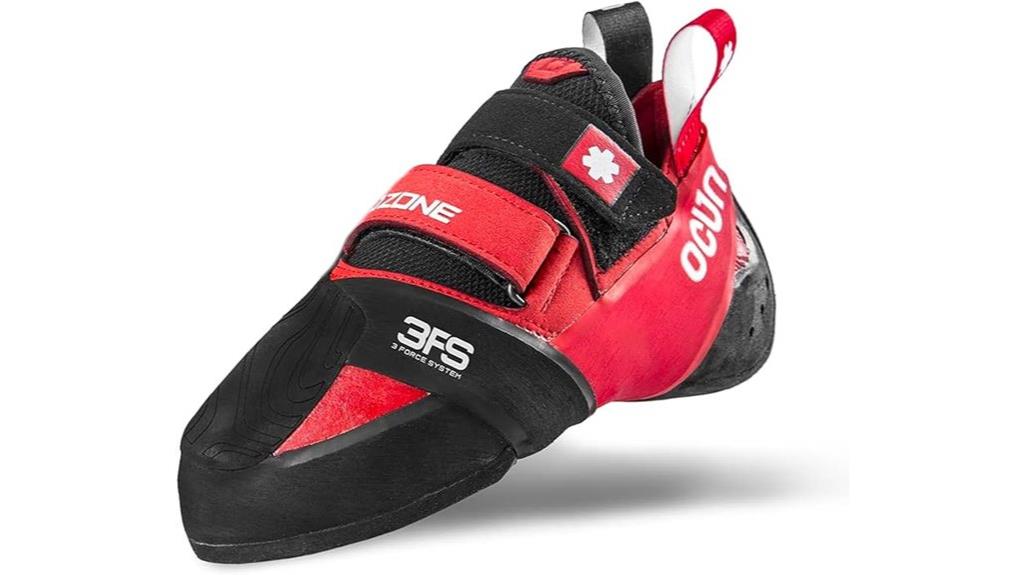
Wider feet and unconventional toe shapes find their perfect match in the Ocun Ozone bouldering shoes. The centered toe box design specifically accommodates Morton’s toe and various foot geometries that struggle with traditional climbing shoe cuts.
You’ll need careful attention to sizing. These shoes require staying true to your street shoe size rather than downsizing aggressively. Users report significant discomfort when going smaller, including blood under nails and excessive toe curling at 90-degree angles.
The sticky rubber sole delivers exceptional grip on small footholds. You’ll experience noticeably improved confidence and footwork precision compared to budget alternatives. The aggressive profile maintains bouldering performance without sacrificing comfort for wider foot types.
Best For: Boulderers with wider feet, Morton’s toe, or unconventional foot shapes who need aggressive performance without sacrificing comfort.
Pros:
- Centered toe box design accommodates Morton’s toe and various foot geometries that struggle with traditional climbing shoe cuts
- Sticky rubber sole provides exceptional grip on small footholds with improved confidence and footwork precision
- Maintains aggressive bouldering performance while offering superior comfort for wider foot types
Cons:
- Sizing can be challenging and requires careful attention to avoid significant discomfort
- Limited availability in the U.S. market
- Some users report the shoes are too narrow even when sizing up appropriately
Factors to Consider When Choosing a Bouldering Shoe
When I’m selecting bouldering shoes, I evaluate five critical factors that directly impact climbing performance and session quality. The fit and sizing determine how precisely you’ll transmit force to footholds, while the shoe’s shape—aggressive downturned versus moderate flat—affects your ability to climb overhanging terrain versus vertical walls. I also examine rubber compound quality for grip, comfort levels for extended climbing sessions, and heel-toe construction for technical hooking maneuvers.
Shoe Fit and Sizing
Finding the right fit separates comfortable climbing sessions from painful ordeals that cut your bouldering short. I recommend downsizing at least half a size from your street shoe size to achieve the snug fit necessary for precise toe and heel engagement. Your foot shape determines sizing strategy—wider feet often require normal sizing or specific wide models rather than aggressive downsizing.
You’ll need to try multiple sizes since performance shoes vary dramatically in fit based on design and intended use. Consider each shoe’s break-in period and material stretch characteristics before making your final decision. Excessive tightness causes pain and blisters, while loose shoes slip during critical moves. The goal is finding that sweet spot where your shoes feel secure without compromising circulation or causing immediate discomfort during extended climbing sessions.
Aggressive Vs Moderate Shape
Shoe shape fundamentally determines your climbing performance and comfort level on the wall. Aggressive shoes feature a pronounced downturn that concentrates power on small footholds and steep overhangs. I recommend these for advanced climbers tackling challenging routes requiring precise footwork. They typically demand sizing down for peak performance but sacrifice comfort during extended sessions.
Moderate shoes offer a flatter profile that prioritizes all-day comfort over specialized performance. They’re ideal for beginners developing technique or climbers focusing on endurance routes. You’ll find they accommodate true-to-size fitting, especially beneficial for wider feet.
Construction differs greatly between shapes. Aggressive models use stiffer rubber compounds optimizing edging precision, while moderate shoes emphasize flexibility for smearing techniques. Consider your climbing style carefully—aggressive shapes excel on technical problems, moderate shapes perform better on longer, less demanding routes.
Rubber Compound Quality
Although climbers often obsess over shoe fit and shape, rubber compound quality makes the difference between sticking an essential hold and sliding off the wall. I evaluate rubber based on three critical factors: grip characteristics, durability, and temperature performance.
Softer compounds excel on smears and slopers where maximum surface contact matters. Firmer rubber provides superior edging precision on small holds and crystals. High-quality compounds maintain their sticky properties longer, resisting the wear that degrades cheaper alternatives after just a few sessions.
Temperature-sensitive formulations perform consistently across conditions. Some compounds stay tacky in cold gyms, while others work better outdoors. I prioritize rubber quality because it directly impacts safety and confidence on challenging problems where every millimeter of contact counts.
Comfort for Extended Sessions
When you’re projecting difficult boulder problems that demand multiple attempts, comfort becomes paramount to maintaining peak performance throughout your session. I recommend choosing shoes with soft construction materials that minimize pressure points and hotspots. The ideal fit balances snugness with circulation—typically achieved by downsizing half a size from your street shoe.
Focus on models that provide ample toe and heel support without restricting natural foot movement. Quality materials reduce the breaking-in period considerably, allowing immediate use during extended sessions. Shoes that maintain structural integrity while offering flexibility prevent the fatigue and pain that compromise your climbing ability.
Proper circulation prevents numbness that forces premature session endings. The right comfort level enables you to concentrate on technique rather than foot discomfort during challenging sequences.
Heel and Toe Performance
Because precise foot placement determines success or failure on challenging boulder problems, heel and toe performance stands as the most critical factor in shoe selection. I prioritize heel hook effectiveness through shoes with snug-fitting heel cups that prevent slippage during dynamic movements. The sensitivity in this area allows me to engage heel hooks with confidence on overhanging terrain.
For toe performance, I focus on stiff toe boxes that deliver maximum precision on small footholds. Aggressive downturned designs concentrate my weight onto the toe, creating superior edging capability on narrow holds. While soft shoes excel at smearing techniques, I prefer stiffer constructions for technical edging where precision matters most. The outsole’s sensitivity directly impacts my ability to feel rock texture, enabling precise foot placement and maintaining balance throughout complex sequences.
Durability and Construction
While heel and toe performance capture immediate attention, durability and construction determine whether your investment pays off over months of hard climbing. I examine three critical elements when evaluating build quality.
Material selection drives longevity. High-grade leather uppers resist stretching better than synthetic alternatives. The rubber compound affects both grip and wear resistance – softer compounds grip better but wear faster.
Construction details matter profoundly. Reinforced stitching prevents seam failure during dynamic moves. A quality rand protects the upper from abrasion and maintains structural integrity. Thicker soles increase durability but reduce sensitivity on micro-holds.
Regular maintenance extends shoe life considerably. Professional resoling costs $40-60 but can triple your shoe’s lifespan. I’ve seen gym climbers get 6-12 months from quality shoes, while outdoor climbers on abrasive rock see 3-6 months typically.
Price and Value
Even the most durable construction means little if the initial price exceeds your budget or fails to deliver proportional value. I evaluate bouldering shoes by their price-to-performance ratio rather than cost alone. Cheaper options often compromise on rubber compounds and construction quality, leading to faster wear and reduced grip performance. Higher-priced shoes typically incorporate advanced rubber technologies and superior materials that extend lifespan and enhance climbing capability.
I calculate total ownership cost by dividing the purchase price by expected climbing sessions. A $180 shoe lasting 200 sessions costs $0.90 per use, while a $90 shoe lasting 80 sessions costs $1.13 per use. User reviews consistently show that mid-to-premium shoes deliver better long-term value through improved durability and performance, justifying their higher initial investment for serious climbers.
On a final note
Selecting the right bouldering shoe depends on your skill level, foot shape, and climbing objectives. The La Sportiva Solution delivers unmatched precision for advanced boulderers, while Ocun’s diverse lineup offers excellent options across all experience levels. Consider downsizing 0.5-1 full sizes from your street shoe for ideal performance. Proper fit guarantees maximum power transfer and prevents injury during dynamic movements.

